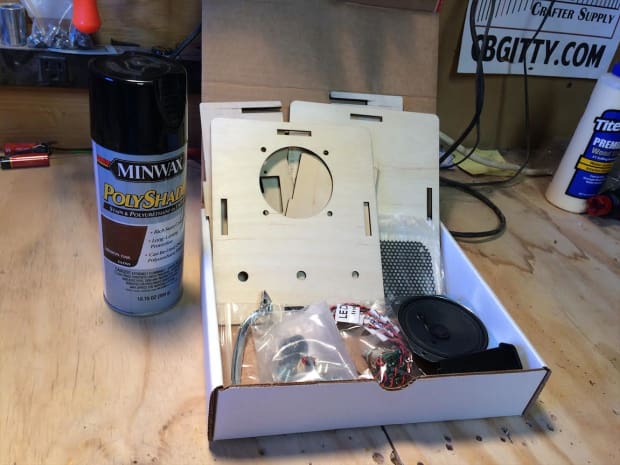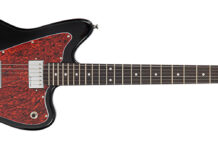![1[2]](https://www.promusic.news/wp-content/uploads/2018/05/1[2]-267x200.jpg)
Build This Simple DIY Guitar Amp Kit
Beware, this is the opposite of almost every other Guitar World amp review! As a DIY musician who plays trash blues, I could give a rat’s heiney about the fine minutiae of frequencies and tube bias. I like to plug a guitar into anything, shove a slide on my finger and write songs. With that said, my wife, Melissa gave me this DIY 2.5 Watt Amp Kit ($49.99 from CBGitty.com), and it was a great project for a couple of evenings. The lunchbox-size amp comes almost completely pre-wired and includes a birch plywood housing.
Let’s start with a demo video using two insane Musicvox MI-5 guitars (six string & 12 string versions).

For me, this was a perfect, “I-should-lighten-up-on-my-drinking-and-do-something-else-at-night” activity. Also, I’ve become one of those guys who spends his evenings smoking cigars in the woodshop and building things. I like to be surrounded by tools and guitar stuff, playing old blues on the stereo and making something musical.
Granted, I’m not a fine luthier. I’m a tinkerer.

I decided to give the amp a nice dark stain and poly finish so that it would look good in my living room. I spent the first evening giving the wood a simple smoothing with some fine steel wool and then coated everything in two coats of dark oak Minwax PolyShade stain/finish. Once that was dry, I used steel wool to smooth it out and make certain areas a bit lighter, giving a slightly relic’d look. Then I gave it two coats of Minwax clear polyurethane.

The amp came with a shiny chrome handle that I knew would clash with the dark stain of the wood, so I antiqued it a bit with Rust-Oleum Forged Hammered spray paint.
Once everything was sprayed and finished, I left it all to dry for the night.

When I got back in the shed the next night, the finish was dry and came out perfectly. I grabbed a cigar from my woodshop humidor (a delicious Java Maduro Robusto, in case you were wondering), put Hound Dog Taylor’s first album on the stereo and proceeded to dry-fit the wood parts of the kit to make sure it was ready for gluing. Ah, a nice tight fit!

The box kit is a simple tab-in-slot style and requires simple wood glue. To keep things clean and tidy, I used a disposable paintbrush to apply the glue where needed. (Why waste the time cleaning and wiping glue drips!)

The face and sides of the amp were glued up and held in place by a couple of rubber bands. I didn’t glue the back yet because I still needed to load the parts. Having just four rubber bands allowed enough space for me to turn the kit over and install the electronics.

The guts of the amp are a simple Artec 2.5 watt board with a volume knob (that doubles as on/off switch) and an LED light. If you’re an electronics nerd or amp connoisseur, this ain’t your amp kit. For the rest of us, this provides enough power to practice in the living room. It’s also mostly complete, everything is labeled and requires only six easy soldering points. It’s perfect for electronic idiots like me.

I mounted the parts in place before soldering. I used a cheap Radio Shack soldering iron and small drops of solder to connect the guitar jack, battery pack and LED light to the accompanying wires.
IMPORTANT: At this stage, I put a battery in and tested the amp. I wanted to make sure everything was assembled correctly before attaching the back. Everything sounded great. I also messed with the tiny screw on the back of the circuit board that serves as a tone trim pot. It sounded best when I turned it all the way up for maximum output.

I used the disposable paint brush to apply glue to the back and finished it up. The kit came with a black Tele style volume knob, but I spent a while going through my drawer filled with old knobs to see if another worked better. Besides, I still had half a cigar left and the Hound Dog Taylor CD was just starting on “Give Me Back My Wig.” It never hurts to keep tinkering.
After going through my endless collection of old knobs, nothing came close to looking as good as the original, so I kept it.

Finished! I was really surprised at how well the dark oak stain came out. It looks great in my living room, and is small enough for the bookshelf. I filmed the demo video below so you can hear the tone for yourself. No, this isn’t a Fender Princeton or anything close to a boutique amp. However, it’s mine, it’s perfect for songwriting as I relax in the living room, I made it with my own damn hands and was fun to build.
And sometimes, that’s all ya need.
Musician and author, Shane Speal is responsible for the resurgence of cigar box guitars in modern music. He fronts the DIY-instrument band, Shane Speal and the Snakes, curates the Cigar Box Guitar Museum inside Speal’s Tavern in New Alexandria, PA, and has made 2,000 cigar box guitars to date. His latest book, Making a Poor Man’s Guitar, (Fox Chapel Publishing, August 2018) combines DIY instrument projects with their deep blues history.
Source: www.guitarworld.com







